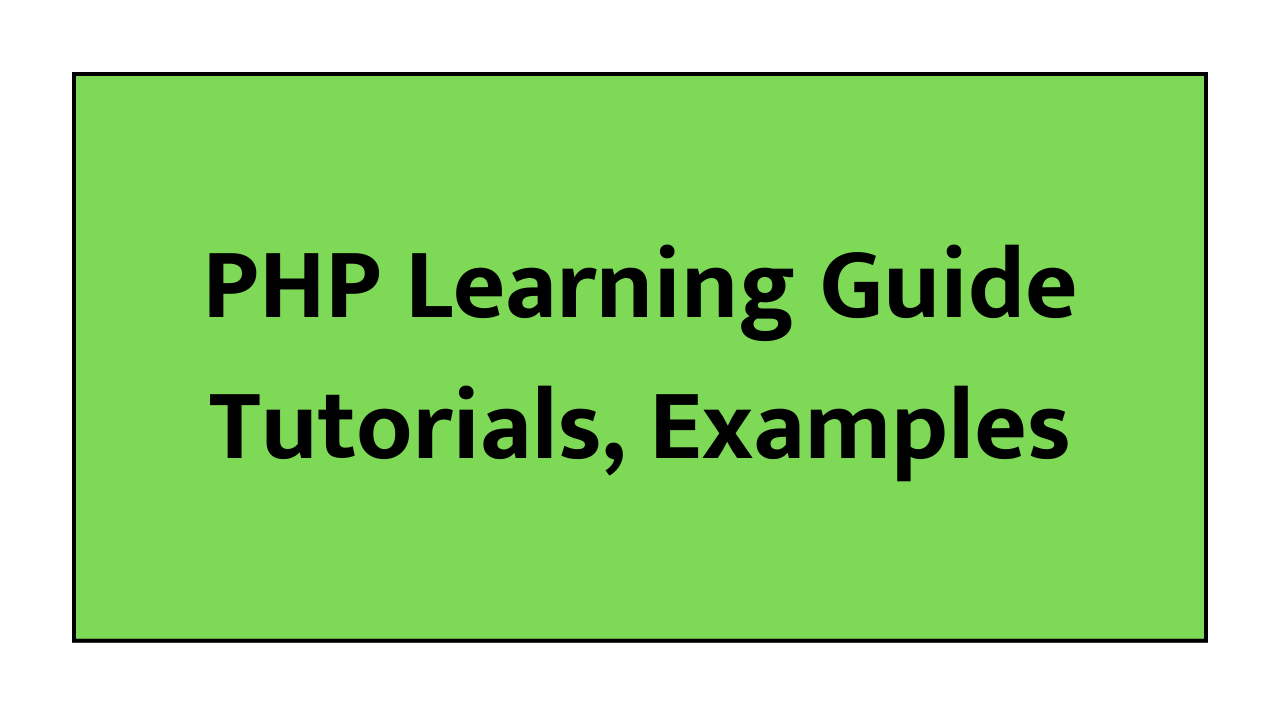PHP Learning Guide Tutorials, Examples
“Learn PHP with our beginner-friendly guide, featuring top tutorials, programming examples, and a comparison between PHP and Python. Start your web development journey today!”
PHP (Hypertext Preprocessor) is a popular scripting language primarily used for web development. It is open-source, easy to learn, and powerful for creating dynamic web pages. If you’re a beginner looking to dive into PHP, this guide will help you get started with the basics, point you to the best tutorials, and provide insights into PHP programming. Additionally, we’ll compare PHP with Python to help you decide which suits your needs better.
What is PHP?
PHP is a server-side scripting language designed to develop web applications and is embedded in HTML. Here’s what makes PHP unique:
- Server-Side Execution: PHP code runs on the server and sends the generated HTML to the client.
- Open Source: It’s free to use and supported by a large community.
- Database Integration: PHP works seamlessly with databases like MySQL, PostgreSQL, and SQLite.
- Cross-Platform: It runs on multiple platforms, including Windows, macOS, and Linux.
Uses of PHP:
- Developing dynamic websites.
- Handling forms and collecting user data.
- Building content management systems (CMS) like WordPress.
- Developing e-commerce applications.
How to Learn PHP for Beginners?
Learning PHP can be easy if you follow a structured approach. Here are steps for beginners:
- Understand the Basics of Web Development: Before diving into PHP, understand the basics of HTML, CSS, and JavaScript.
- Install a Local Server: Install tools like XAMPP, WAMP, or MAMP to create a local environment for testing PHP code.
- Start with Basic PHP Syntax:
- Learn how to declare variables, use loops, and work with arrays.
- Understand how PHP handles forms and processes user inputs.
- Explore PHP Functions: PHP offers built-in functions for file handling, string manipulation, and database interaction. Practice these to solidify your knowledge.
- Work with Databases: Learn how to connect PHP with a database like MySQL to build dynamic applications.
- Build Small Projects: Start with simple projects like a login system, a contact form, or a guestbook.
- Join the Community: Engage in forums like Stack Overflow, Reddit, or PHP-specific communities to seek help and share knowledge.
Best PHP Tutorials for Beginners
To learn PHP effectively, it’s essential to have the right resources. Here are some of the best tutorials and platforms:
- PHP.net (Official Documentation): The official PHP website is an excellent resource for learning PHP functions, libraries, and updates.
- W3Schools:
- Offers easy-to-understand tutorials with interactive examples.
- Covers PHP basics, form handling, and database integration.
- Codecademy: Provides hands-on practice through interactive lessons and real-world projects.
- Udemy Courses:
- “PHP for Beginners” by Edwin Diaz.
- “Build a CMS with PHP and MySQL” for practical experience.
- YouTube Channels:
- Programming with Mosh.
- Traversy Media.
- Both channels offer beginner-friendly tutorials with real-world examples.
- Books:
- PHP and MySQL Web Development by Luke Welling.
- PHP Cookbook by David Sklar.
- FreeCodeCamp:
- Offers in-depth articles and video tutorials covering PHP basics to advanced topics.
PHP Programming Examples
Here are some beginner-friendly examples to help you understand PHP better:
1. Hello World:
<?php
echo "Hello, World!";
?>
2. Simple Form Handling:
<html>
<body>
<form method="post">
Name: <input type="text" name="name">
<input type="submit">
</form>
<?php
if ($_SERVER["REQUEST_METHOD"] == "POST") {
$name = htmlspecialchars($_POST['name']);
echo "Hello, " . $name;
}
?>
</body>
</html>
3. Connecting to a Database:
<?php
$servername = "localhost";
$username = "root";
$password = "";
$dbname = "test";
// Create connection
$conn = new mysqli($servername, $username, $password, $dbname);
// Check connection
if ($conn->connect_error) {
die("Connection failed: " . $conn->connect_error);
}
echo "Connected successfully";
?>
PHP vs Python: Which is Better?
Choosing between PHP and Python depends on your specific requirements. Here’s a comparison to help you decide:
| Feature | PHP | Python |
|---|---|---|
| Purpose | Designed for web development | General-purpose, versatile language |
| Ease of Learning | Beginner-friendly for web tasks | Easy to learn for all applications |
| Frameworks | Laravel, CodeIgniter | Django, Flask |
| Performance | Improved in PHP 8+ | Generally faster with modern interpreters |
| Community Support | Large community | Extensive community |
| Applications | Best for web applications | Suitable for web, AI, ML, and more |
When to Choose PHP:
- For web development, especially when working with existing CMS like WordPress.
- If you need fast deployment for websites.
When to Choose Python:
- For projects involving AI, machine learning, or data analysis.
- If you prefer a cleaner syntax for general-purpose programming.
PHP remains a powerful and accessible language for web development. By understanding its basics, following structured tutorials, and practicing with examples, you can master PHP quickly. While Python has gained popularity for its versatility, PHP continues to shine in the web development domain with its specialized tools and frameworks.
By investing time in learning PHP and building real-world projects, you’ll not only enhance your programming skills but also open doors to exciting opportunities in web development. Start your PHP journey today and become a proficient developer!


![Top Python Interview Topics: A Beginner’s Guide for Students [Latest 2025]](https://developer.thrend.in/wp-content/uploads/2025/11/ChatGPT-Image-Nov-18-2025-02_21_01-PM.png)
